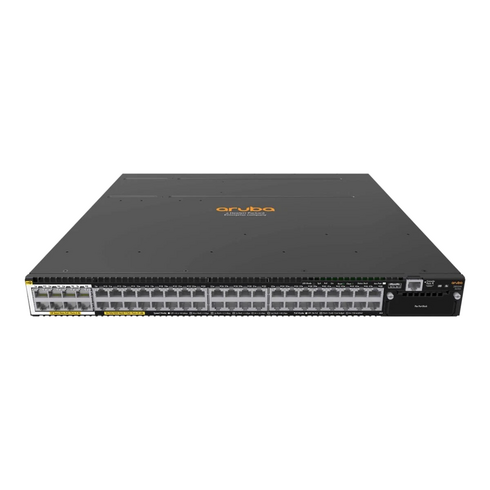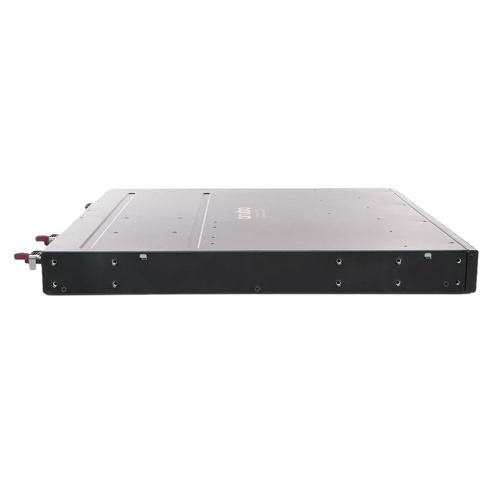JL430A HPE Aruba24-Port Network Switches - Managed Rack-mountable
- — Free Ground Shipping
- — Min. 6-month Replacement Warranty
- — Genuine/Authentic Products
- — Easy Return and Exchange
- — Different Payment Methods
- — Best Price
- — We Guarantee Price Matching
- — Tax-Exempt Facilities
- — 24/7 Live Chat, Phone Support
- — Visa, MasterCard, Discover, and Amex
- — JCB, Diners Club, UnionPay
- — PayPal, ACH/Bank Transfer (11% Off)
- — Apple Pay, Amazon Pay, Google Pay
- — Buy Now, Pay Later - Affirm, Afterpay
- — GOV/EDU/Institutions PO's Accepted
- — Invoices
- — Deliver Anywhere
- — Express Delivery in the USA and Worldwide
- — Ship to -APO -FPO
- — For USA - Free Ground Shipping
- — Worldwide - from $30
Overview of HPE JL430A Aruba 3810m Switch
Switch Specifications
- Type of Device: 24-Port Managed Switch
- Form Factor: Rack-mountable 1U
- Ethernet Type: Gigabit Ethernet
- Total Ports: 24 x 10/100/1000 Mbps
Performance Metrics
Routing and Switching Capacity
- Switching Fabric Bandwidth: 169 Gbps
- Routing Capacity: 160 Gbps
- Latency:
- 1 Gbps: 2.8 microseconds
- 10 Gbps: 1.8 microseconds
- Packet Throughput: 95.2 Mpps (for 64-byte packet size)
Memory Capacity
- Routing Tables: Up to 10,000 entries
- MAC Address Table: 64,000 entries
Supported Routing Protocols
- OSPF
- BGP-4
- RIP-1 & RIP-2
- BGP
- OSPFv2 & OSPFv3
Remote Management Protocols
- SNMP (Versions 1, 2c, and 3)
- RMON (Versions 1, 2, 3, and 9)
- SSH-2
- XRMON
Security Features
- Encryption Protocol: SSL
- Authentication Methods:
- RADIUS
- TACACS+
Key Functional Features
- Flow Control Support
- Full Duplex Capability
- DHCP Support
- BOOTP Support
- VLAN Support
- Syslog Support
- DiffServ Support
- sFlow Support
- Multiple Spanning Tree Protocol (MSTP) Support
- Quality of Service (QoS)
- Support for Jumbo Frames
- LLDP Support
- Link Aggregation Control Protocol (LACP)
Compliance Standards
- IEEE 802.1d
- IEEE 802.1q
- IEEE 802.1p
- IEEE 802.3x
- IEEE 802.3ad (LACP)
- IEEE 802.1w
- IEEE 802.1s
- IEEE 802.1ad
- IEEE 802.1v
- IEEE 802.1ax
Connectivity and Expansion Options
Interface Details
- 24 x 1000Base-T (RJ-45)
- 1 x Network Stack Device
- 1 x Console Port (RJ-45)
- 1 x Management LAN Port (RJ-45)
- 1 x Micro-USB Port
Expansion Slot Information
- Available Expansion Slots: 1 (total)
- Free Slots: 1
Power Specifications
Power Supply Details
- Power Device: Internal Hot-plug Power Supply
- Installed Power Supply Units: 1
- Maximum Power Supply Units: 2
- Redundant Power Supply: Yes, with 1+1 scheme
- Output Power: 250 Watts
- Operating Voltage: DC 12V
Management
The HPE Aruba JL430A Network Switches come with a powerful management feature that sets them apart from other switches in the market. With their managed capabilities, these switches provide users with complete control over their network infrastructure, allowing for efficient and effective management of network resources.
Benefits of Managed Switches
Managed switches offer numerous benefits to users, making them an essential component of any network infrastructure. Some of the key advantages include:
Network Performance Optimization
Managed switches provide users with the ability to optimize network performance by controlling traffic flow, bandwidth allocation, and prioritization. With the ability to configure Quality of Service (QoS) settings, users can ensure that critical applications receive the necessary network resources, resulting in improved performance and reduced latency.
Enhanced Security
Security is a major concern for any organization, and managed switches play a crucial role in ensuring network security. These switches offer features such as access control lists (ACLs), VLANs, and port security, allowing administrators to define and enforce security policies. By implementing these security measures, users can protect their network from unauthorized access and potential threats.
Remote Monitoring and Troubleshooting
One of the standout features of managed switches is their ability to be remotely monitored and troubleshooted. This means that administrators can easily access switch configurations, monitor network traffic, and troubleshoot issues without having to physically be present at the switch location. This remote management capability greatly reduces downtime and allows for quick resolution of network issues.
Importance of Managed Switches
In today's highly connected world, where businesses heavily rely on their networks for critical operations, the importance of managed switches cannot be overstated. Here are a few reasons why managed switches are vital for any organization:
Network Scalability
As businesses grow, their network requirements also increase. Managed switches provide the scalability needed to accommodate the growing demands of a network. With features like link aggregation, VLAN support, and Spanning Tree Protocol (STP), these switches enable users to easily expand their network without compromising performance or stability.
Optimized Resource Allocation
Managed switches allow for fine-grained control over network resources, ensuring that bandwidth is allocated appropriately to different applications and users. This optimization leads to better overall network performance, as critical applications can be prioritized while non-essential traffic is given lower priority.
Network Segmentation
Segmenting a network into multiple virtual LANs (VLANs) is a common practice in modern network design. Managed switches provide the necessary tools to create and manage VLANs effectively, allowing for better network organization and improved security. By isolating different parts of the network, users can prevent unauthorized access and limit the impact of potential security breaches.
Mounting
The HPE Aruba JL430A Network Switches offer a rack-mountable design that ensures easy installation and efficient space utilization. This feature makes them an ideal choice for data centers, server rooms, and any other environment where space is a premium.
Benefits of Rack-Mountable Switches
Rack-mountable switches offer several advantages over their non-rack-mountable counterparts. Let's explore some of these benefits:
Space Efficiency
In crowded networking environments, space efficiency is crucial. Rack-mountable switches allow for vertical stacking in standard server racks, maximizing the utilization of available space. By consolidating switches into a single rack unit (RU), users can significantly reduce the footprint required for their networking equipment.
Organized Cable Management
Rack-mountable switches promote organized cable management, which is essential for maintaining a tidy and HPE JL430A Enhanced Security Switch infrastructure. These switches typically feature rear-facing ports, allowing for cleaner cable routing and reducing the risk of cable congestion or accidental disconnections. Neat and organized cabling not only improves aesthetics but also simplifies troubleshooting and maintenance tasks.
Scalability and Flexibility
Rack-mountable switches offer scalability and flexibility, enabling users to easily add or remove switches as their network requirements change. With a standardized rack infrastructure, users can quickly deploy additional switches without the need for complex reconfiguration. This scalability ensures that the network can grow alongside the organization's needs.
Ports
The HPE Aruba JL430A Network Switches boast 24 ports, providing users with ample connectivity options for their network devices. The abundance of ports is one of the key features that make these switches suitable for small to medium-sized businesses, as well as larger enterprises.
Benefits of 24 Ports
Having 24 ports on a network switch offers several benefits, making it an ideal choice for various scenarios:
Device Connectivity
The 24 ports on the HPE Aruba JL430A Network Switches allow users to connect a wide range of devices, including computers, servers, printers, IP phones, and more. This versatility ensures that all essential network devices can be easily integrated into the network infrastructure without the need for additional switches or complicated configurations.
Room for Expansion
Even if an organization does not currently require all 24 ports, having extra capacity allows for future expansion. As the business grows or new devices are added to the network, having spare ports readily available saves time and effort in deploying additional switches. This scalability ensures that the network can adapt to changing requirements without major disruptions.
Redundancy and Failover
The abundance of ports on the JL430A Network Switches also enables the implementation of redundancy and failover mechanisms. By connecting critical devices to different ports, users can create redundant paths in the network, ensuring that if one link fails, traffic can automatically be rerouted through an alternative path. This redundancy minimizes downtime and improves network reliability.
Conclusion
The HPE Aruba JL430A Network Switches provide users with a comprehensive set of features that are essential for efficient and reliable network management. With their managed capabilities, rack-mountable design, and ample port availability, these switches offer the flexibility, scalability, and performance required in modern networking environments. Whether it's optimizing network performance, enhancing security, or simplifying network expansion, these switches deliver the functionality needed to meet the demands of today's businesses.













